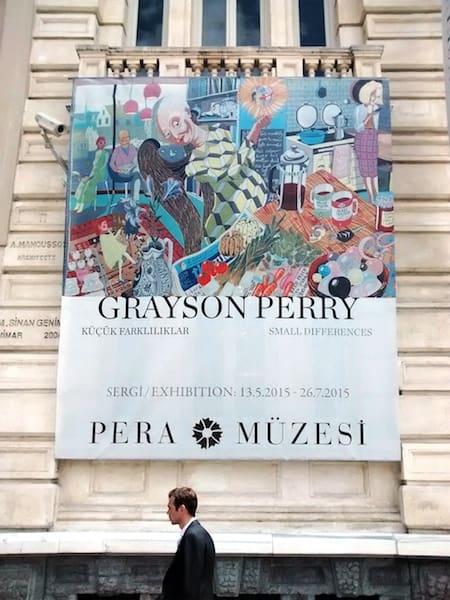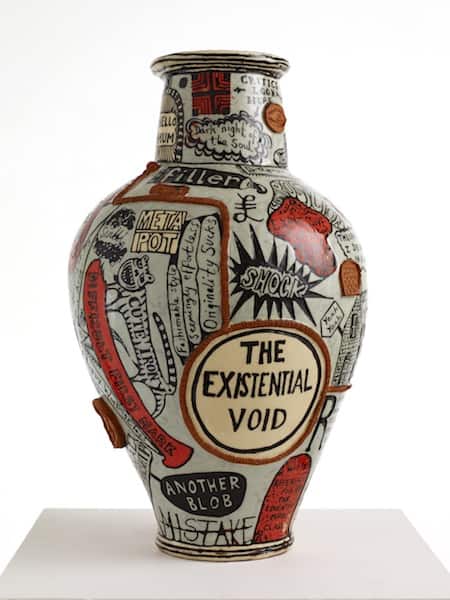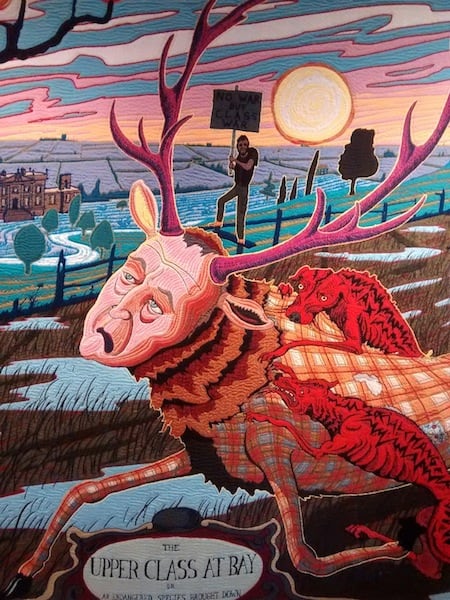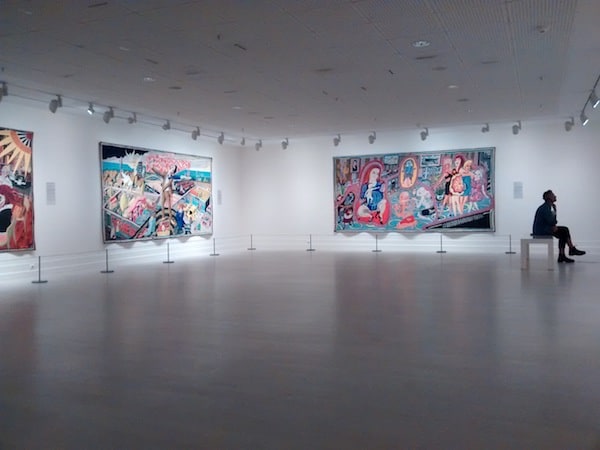This impressive and satisfying show at the Pera Museum by acclaimed British artist Grayson Perry has everything to love about contemporary art. Grayson Perry’s work is conceptually thorough, historically grounded, expertly executed and thoughtfully conceived through thousands of man-hours in the studio. This thoughtfulness and attention make for a rich viewing experience, allowing the work to be appreciated on a number of different levels, not the least of which is an active and aesthetically pleasing experience for the viewer.

The show came to Turkey by way of the British Council Collection. As stated in their mission, they aim to introduce the work of contemporary British artists to a wider audience the world over. Together with the Pera Museum, they organized Small Differences, a large-scale six tapestry series by the artist. The razor-sharp curatorial team at the Pera Museum decided to exhibit a larger body of Perry’s work so as to display Small Differences in a broader contextual framework. This added context also serves to sharpen your senses to Perry’s tone and manner of discourse before viewing his featured series.
In Smalls Differences, Perry investigates a nagging and seemingly ambiguous distinction—the minute differences in taste of the working, middle and upper classes of Britain. You can see him pull apart these paper-thin distinctions in his daedal and colorful tapestries about class, taste and the formation of self within one’s community or ‘tribe’. Following the path of his main character, Tim Rakewell, Perry aims, in part, to answer the question, “When people say they ‘like’ something, what do they mean?”
The thirteen additional works, borrowed from various collections, include five large-form, traditionally thrown/sculpted ceramic vases in classical forms, one large, hand-built ceramic figure, two large, machine-made tapestries, one smaller, handmade textile and four multi-plate etchings. The handmade tapestry, Vote Alan Measels for God (2007) is a particularly bold choice for the Pera. Though by the artist’s own account it is “ambiguous” in meaning, it is nonetheless controversial in its use of what many consider inflammatory images that refer to Islam, capitalism, and acts of terror.

The tapestries and vases are social in nature and speak to a variation of circumstances affecting the human condition, including consumerism, taste, and theology, to name a few. The bold and colorful quilts pointing to the inner workings of the artist’s mind appear in contrast to—but are not at odds with—the smaller, black and white etchings. These prints aim to light the path to Perry’s deeply personal and self-aware voyage of introspection. Drawn as maps, they identify (name) and survey the vast areas of the artist’s own psyche, heart, and mind. They match the tapestries in intensity with their exquisitely minuscule details and blankets of dense text.
In fact, his effective use and integration of text is present throughout the show—all but one of the selected works includes text. On his vases he quotes critics, gives voice to an existential struggle, as well as to inanimate objects, tells the story of a modern-day savior (sadly thwarted by capitalism) and evokes the names of great thinkers, albeit Christian fundamentalists.
In the tapestries, text is literally woven into them, either as naming or to frame the narrative. In the Walthamstrow tapestry he follows the life cycle of man from infancy to death while presenting various figures and buildings accompanied by brand names, which seem to take the place of personal names, family names, and proper nouns. Vodafone sacrifices its baby to the devil and Coca-Cola underlines childhood and a morbid Christianity, while the ‘prudential’ hand, like a colophon, appears even before birth with a business card. Later, the castle named Starbucks is open for business and IKEA huddles in a fetal position and cries.
As theorist Roland Barthes said in Rhetoric of the Image, this text, including names, guide us “by recourse to a nomenclature.” But why brand names? Our name becomes a signifier for us, both to ourselves and to others. If our name, ideally, evokes us, what does it mean to put the name of a brand on your body? For instance, the ubiquitous GAP sweatshirt on Perry’s vase titled Taste and Democracy.

In Small Differences, six compositions follow the life of Tim Rakewell, a working class boy who rises above his station. Here, Perry interrogates our tastes in the form of a detailed fable for the modern day. As is the case with complicated, intangible things, tastes cannot be named, explicitly; rather, Perry points to them from many angles.
His investigation is conducted through historical grounding, by way of homage and thoughtful observations that are procured in an utterly modern fashion, a ‘reality’ TV series. He utilizes classical compositions and references to famous works of art in their construction. For instance, the series is loosely molded after British artist William Hogarth’s The Rake’s Progress, which is on display in its entirety in an adjoining gallery.
Perry’s three-part television documentary is also on view in its entirety at the gallery. Though one does not need this video accompaniment to appreciate Small Differences, it provides insight into the artist’s process. These videos introduce us to the real people on which his characters are based: scenes from their everyday lives are montaged and displayed through incredibly detailed vignettes. His subjects are uniformly thrilled and honored to be a part of the work, even though it is challenging and raw in places. It’s clear that they love and respect him, a true testament to Perry as a person.

Indeed, this subject matter is close to Perry’s heart. To some degree the story is autobiographical: Tim Rakewell resembles a young Perry, who also comes from a working class background and achieved great success. In Annunciation of the Virgin Beast (2012), Perry nods to his anthropological and sociological investigation with a small, mindful self-portrait. The artist can be seen holding a camera in a small mirror; he does not hide within the work. As Perry has said before, “It’s hard to mask one’s social and cultural identity over a lifetime, it will eventually leak out.”
In his ceramic vase, Taste and Democracy, Perry quotes a reaction to him being awarded the prestigious Turner Prize: “Sincerity is the new shocking.” In light of the fast pace of today’s consumerism and capitalism, and the over-saturation of idyllic constructions of everyday life on social media, these tapestries are powerful and attentive. Read their text and follow their threads—I think you will find that, indeed, sincerity is the new shocking.
For more information on the exhibition, which closes on Sunday 26 July, click here.











Superb review . Love Grayson Perry’s work . Really well done .
Thank you, Jill. I think, “over-saturation of idyllic constructions of everyday life on social media” might have struck a cord with you 😉 Among other things. But really, this show is great!
Daedal. That’s a new one for me: Thanks!
Great review as always Missy 🙂